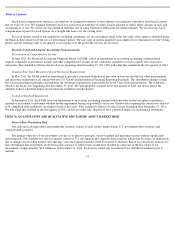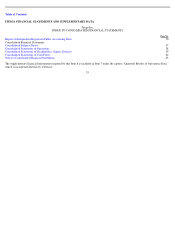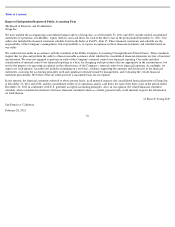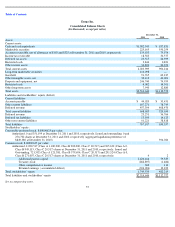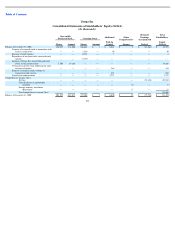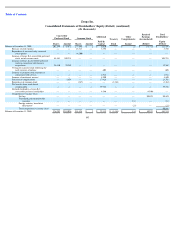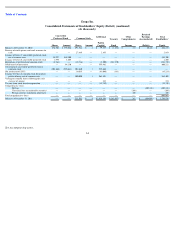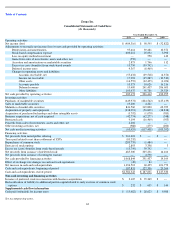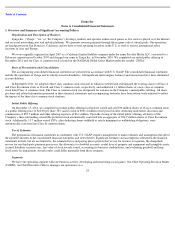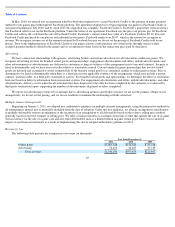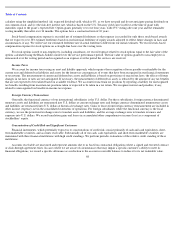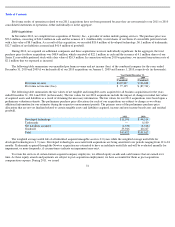Zynga 2011 Annual Report Download - page 67
Download and view the complete annual report
Please find page 67 of the 2011 Zynga annual report below. You can navigate through the pages in the report by either clicking on the pages listed below, or by using the keyword search tool below to find specific information within the annual report.
Table of Contents
Zynga Inc.
Notes to Consolidated Financial Statements
1. Overview and Summary of Significant Accounting Policies
Organization and Description of Business
Zynga Inc. (“Zynga,” “we” or “the Company”)
develops, markets and operates online social games as live services played over the Internet
and on social networking sites and mobile platforms. We generate revenue primarily through the in-game sale of virtual goods. Our operations
are headquartered in San Francisco, California, and we have several operating locations in the U.S. as well as various international office
locations in Asia and Europe.
We were originally organized in April 2007 as a California limited liability company under the name Presidio Media LLC, converted to a
Delaware corporation in October 2007 and changed our name to Zynga Inc. in November 2010. We completed our initial public offering in
December 2011 and our Class A common stock is listed on the NASDAQ Global Select Market under the symbol “ZNGA.”
Basis of Presentation and Consolidation
The accompanying consolidated financial statements are presented in accordance with U.S. GAAP. The consolidated financial statements
include the operations of Zynga and its wholly-owned subsidiaries. All significant intercompany balances and transactions have been eliminated
in consolidation.
In September 2011, we adopted a three class common stock structure in which we retitled and redesignated the existing classes of Class A
and Class B common stock as Class B and Class C common stock, respectively, and authorized 1.1 billion shares of a new class of common
stock titled Class A common stock. The Class A common stock was designated for issuance in the Company’s initial public offering. All share,
per share and related information presented in these financial statements and accompanying footnotes have been retroactively adjusted to reflect
the impact of the three class common stock structure.
Initial Public Offering
On December 15, 2011, we completed our initial public offering in which we issued and sold 100 million shares of Class A common stock
at a public offering price of $10.00 per share. We raised a total of $961.4 million of net proceeds after deducting underwriter discounts and
commissions of $32.5 million and other offering expenses of $6.1 million. Upon the closing of the initial public offering, all shares of the
Company’s then-outstanding convertible preferred stock automatically converted into an aggregate of 304.9 million shares of Class B common
stock. Additionally, 15.7 million vested ZSUs, after deducting shares withheld to satisfy minimum tax withholding obligations, were
automatically converted into Class B common shares.
Use of Estimates
The preparation of financial statements in conformity with U.S. GAAP requires management to make estimates and assumptions that affect
the reported amounts in the consolidated financial statements and notes thereto. Significant estimates and assumptions reflected in the financial
statements include, but are not limited to, the estimated lives and paying player periods that we use for revenue recognition, the chargeback
reserve for our third-
party payment processors, the allowance for doubtful accounts, useful lives of property and equipment and intangible assets,
accrued liabilities, income taxes, fair value of stock awards issued, accounting for business combinations, and evaluating goodwill and long-
lived assets for impairment. Actual results could differ materially from those estimates.
Segments
We have one operating segment with one business activity, developing and monetizing social games. Our Chief Operating Decision Maker
(CODM), our Chief Executive Officer, manages our operations on a
63


